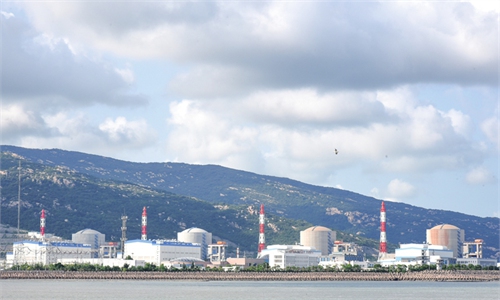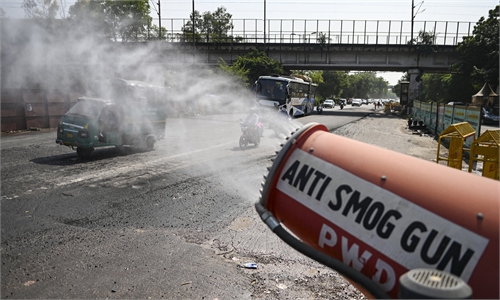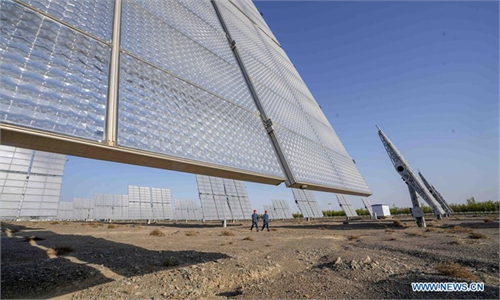IN-DEPTH / IN-DEPTH
China brings back blue skies in green devt by winning the battle against air pollution
Colors of prosperity

Blue sky over Beijing CBD. Photo: IC
A battle that perfectly exemplifies the Chinese authorities' determination in building a prosperous and beautiful country is the fight against air pollution, which over the years has claimed some major stepwise victories thanks to the tough and comprehensive administrative policies by the government, public participation, and the application of scientific technologies.
People living in the northern part of the country likely remember the trauma of smog, an unwelcome mainstay in winter time a decade ago. After years of tackling air pollution, the Beijing-Tianjin-Hebei region and its environs saw a decrease in PM2.5 concentration of up to 37.5 percent in the autumn and winter of 2020 when compared with the same period in 2016, and the total number of days of heavy pollution decreased by 70 percent.
In the Yangtze River Delta region, one of China's most developed economic zones, heavy pollution has essentially been eliminated.
To counter air pollution, winning the battle to defend the blue skies is a major decision and deployment made by the 19th National Congress of the Communist Party of China (CPC). It is related to meeting the people's growing needs for a better and healthier life, building a moderately prosperous society in a well-rounded way, high-quality economic development, and the construction of a beautiful China.
But the process has also seen difficulties, barriers, and growing pains. At times, conserving the environment and ecology comes at a cost to economic benefits and delays development in some regions.
Luckily, the theory of "clear waters and lush mountains are invaluable assets" put forward by President Xi Jinping has won profound support among the people. When see the clear blue of the sky and the array of stars reemerge in the sky, all sacrifices made are worth it.
Now that China has promoted its goals to reach its carbon emission peak before 2030 and achieve carbon neutrality before 2060, the battle has been upgraded to an integrated pursuit of reducing pollution and carbon emissions, in order to realize green development.
No pains, no gains
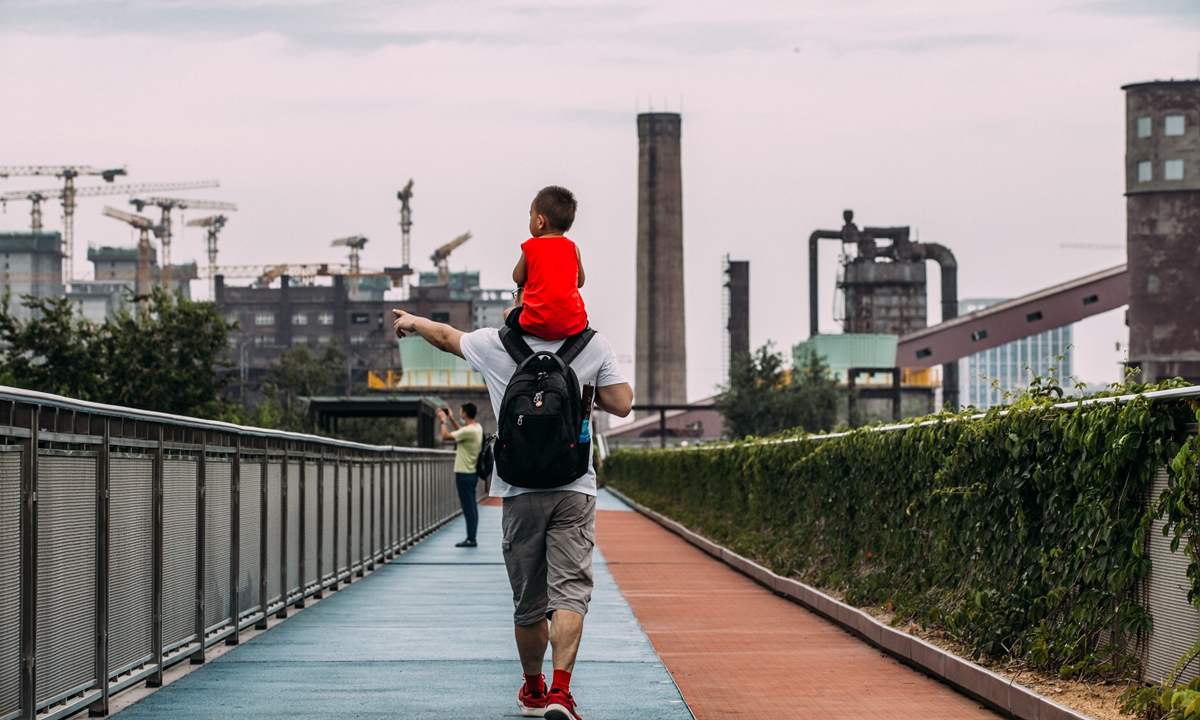
A father and son stand on an elevated trestle converted from an old pipeline at the Shougang compound in July 2020. Photo:Li Hao/GT
Li Hai still remembers the charred coal smell in the air.
Li, now in his 30s, is proud to be a child raised in Shougang, or the Capital Steel, which used to be one of Beijing's most iconic State-owned factories with a glorious history.
However, in Li's memory, there were not only creamy popsicles and tasty sodas which were only sold in Shougang, but also turbid water and dirt and an acrid smell constantly lingering in the air - the feeling of pollution.
Where his family lives now used to be the least favorite option for employees to settle down two or three decades ago. At that time his area was called the "village of casting," in which several giant tube-shaped buildings consistently billowed with smoke.
In the early 2000s, with the approaching of the Beijing Olympics in 2008 and the need for industrial restructuring, removing or closing highly pollutant enterprises inside the capital became urgent. On June 30, 2005, Shougang started to close its production in Beijing and began to relocate amid tears of its workers.
In the following years, more than 60,000 workers out of Shougang's 83,000-strong labor force were relocated, including many choosing to work in the new location of Shougang in Caofeidian of Hebei Province, which is 300 kilometers away from Beijing.
"My two uncles went to Caofeidian. The shuttle bus would take three hours one way," Li told the Global Times.
Today, the former Shougang factory compound has been changed into the workplace of the Beijing Organizing Committee for the 2022 Olympic and Paralympic Winter Games, and the giant tubes have been renovated into low-carbon office spaces.
Shougang's cessation of production and subsequent relocation is one of the first measures that marked China's determination to end air pollution.
In 2011, many cities in China suffered from severe smog pollution, which triggered heated discussions and drew the attention of the international community. At the time, one of the focuses of the debate was whether the data of PM2.5, a main pollutant found in smog, should be monitored and published.
After listening to the voices of the public, in November 2011, PM2.5 was quickly included in the air quality monitoring. A year later, 74 cities in the country were already able to publish their respective PM2.5 data hourly. After another 10 months, the number jumped to 190 cities and in November 2014, 380 cities were doing it.
Monitoring and publishing the air quality index (AQI) is just the first step. The Chinese government promulgated the "Air Pollution Prevention Action Plan" in 2013, which was instructional in tackling air pollution and saw effects soon after.
That year, Hebei Province alone closed 8,347 highly polluting factories. The overall measures to reduce smog cost the province 3 percent of its annual GDP in 2013.
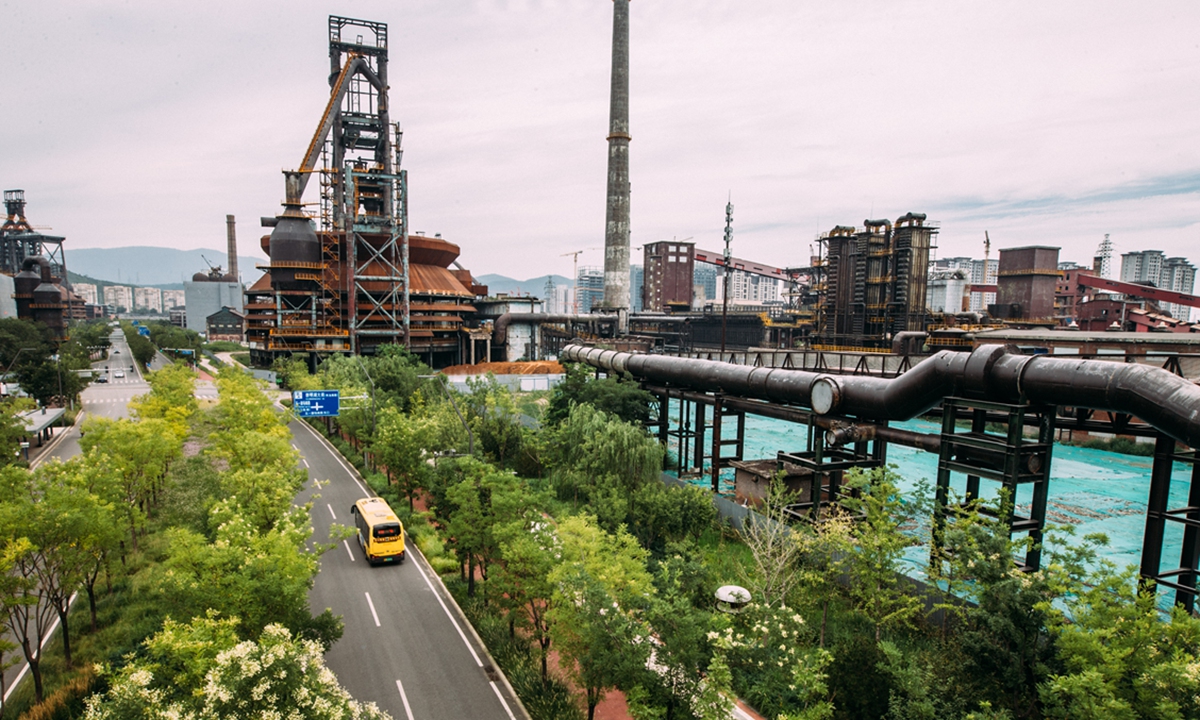
A view of current Shougang compound in Beijing. Photo: Li Hao/GT
Following these decrees, in 2018, China started a campaign to streamline the fight to defend the blue skies, which called for measures such as optimizing industrial layout, strictly controlling the production capacity of high pollutant and high emission industries, and maintaining green industries with great support.
In 2016, 254 out of a total of 338 cities in the country exceeded environmental air quality standards, accounting for 75.1 percent of all cities. There were, in total, 3,248 days of severe pollution in 338 cities. While in 2020, it is shown that the proportion of days with severe pollution or worse had dropped to 1,497 days in total.
A combination of measures
In the campaign to maintain the blue skies in China, technologies and public involvement are key.
Along with the battle to tackle air pollution, the Blue Map, China's first public environmental database APP, has played a surprising role.
In the Blue Map, users have access to real-time data on the quality of air, water, the earth, and other indices at any time in 337 cities in 31 provincial regions in China. Users could also obtain real-time pollution data from more than 40,000 factories in the country.
Ma Jun, director of the Beijing-based Institute of Public and Environmental Affairs, and founder of the Blue Map APP, said he has witnessed the impact of air and water pollution on the population and would like to contribute to greater public engagement in environmental protection work.
Through the APP, users can submit "micro-reports" of the environmental condition around them, especially against local pollutant factories.
The APP now has more than 10 million downloads. Moreover, many local governments have been actively contributing to and cooperating with Ma's team in managing local pollution and monitoring environmental quality.
"The combination of innovation and public participation is key to its success," Ma told the Global Times.
Scientific and technological innovations have provided strong support to China in winning the battle against pollution since 2016, Li Haisheng, president of the Chinese Research Academy of Environmental Sciences, told the Global Times.
According to Li, the central government has attached great importance to scientific pollution control and set up special projects for key bits of research as well as a Prime Minister's Fund.
"Technology has helped with achieving high-level protection of the ecological environment and high social economic quality. It is a win-win development," Li said.

